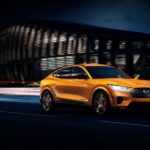If the car industry has awkward teenage years, it’d be the 1970s. The government was totally grounding all the vehicle manufacturers, forcing them to prioritize emission control over unfettered power. There were plenty of growing pains during this transitional period, but the ‘70s turned out to be a memorable decade for the industry. Car dealers stocked with classics from the ‘70s are positioned to profit marvelously, as several vehicles from this decade – especially the American Muscle variety – have appreciated astronomically in value. Yet, the ‘70s have more to offer than pony cars with big engines. Read on for the best of the best of the 1970s in six different categories: performance, economy, style, cultural impact, utility, and most interesting.
Performance – 1971 Plymouth ‘Cuda
The year 1970 marked the beginning of a new chapter for the dauntingly-named Plymouth Barracuda. It kicked off its third generation in a big way, with the introduction of the Plymouth ‘Cuda, a sport-oriented version of the vehicle. The ‘Cuda had a wider, lower stance than its predecessor and was offered either as a coupe or a convertible. The most muscular of the ‘Cudas were powered with one of Chevy’s big-block engines, a 7.0-liter Hemi V8 that absolutely ripped. It made 425 hp and was one of the fastest cars of its segment at the time, with a 0-60 mph acceleration time of 5.8 seconds. It was paired with a 4-speed manual transmission and an ergonomic grip shifter made by Hurst Performance. The high-performer worked its way to the top of the American Muscle car ranks, alongside household names like the Ford Mustang. The ‘Cuda does commit one major automotive faux pas: fake vents. It pulled them off better than most, though, considering its namesake and the vents’ resemblance to gills.
Economy – 1973 AMC Gremlin
The AMC Gremlin made its debut on April Fool’s Day in 1970. Said to have been sketched by Dick Teague on a barf bag while he was in an airplane, the Gremlin was backed by a clever marketing scheme and did pretty well, despite its off-putting name. Throughout the 1970s, manufacturers were trending towards smaller vehicles with higher fuel efficiency, and a lot of cars in this segment ended up with similar body styles. The name of the game for the Gremlin was product differentiation, and one of the ways AMC achieved this was by offering the vehicle in a hatchback. The Gremlin was designed simply but elegantly, derived from AMC’s Hornet, and inexpensive to manufacture. In this case, cheap didn’t equate to poor quality; it proved to be more reliable than Ford and GM’s submissions for this vehicle segment, despite these companies being much larger.
Style – 1972 Volkswagen Type 2
The Volkswagen Type 2 is a visual icon synonymous with peace and love. Better known as the Volkswagen Kombi, Transporter, or simply Microbus, the colorful van calls to mind a very specific era. It was technically a light commercial vehicle but was popular amongst families and counterculture nomads alike, thanks to ample interior space and vibrant good looks. It’s pure happiness on wheels; if you spot one with peace signs and flowers painted all over it, you might even buy that it came out of the factory that way. Nothing about the design was too severe or serious; even the varieties that have spare tires square in the middle of the front end don’t look as goofy as they should. The second generation of the Volkswagen Type 2, called T2, debuted in 1967 and ran through 1979. It had a cleaner look than the first generation, called T1, and fewer, larger windows in place of rows of little airplane-style windows. It carried over bright, two-tone paint options, spherical headlights, and a body like a loaf of bread.
Cultural Impact – 1972 Chevy El Camino
When Chevy introduced the El Camino, it was a vehicle that muddied the lines between car segments. It slowly gained traction, eventually outselling its primary competitor, the Ford Ranchero. It was designed for buyers with varied needs, those who desired a vehicle they could “take to church on Sunday that could carry pigs to market on Mondays,” as the old saying goes. The El Camino could work hard, but it was going to look good at the same time. The 1972 model year was a sweet spot for the El Camino, the last year of the third generation, which outperformed subsequent generations due to the implementation of government mandates that made the car environmentally friendlier. These days, it’s a cult classic and one of Hollywood’s darlings, often making cameos in movies and music.
Utility – 1978 Ford Bronco
In the late ‘70s, the off-roading SUV was on the rise. Introduced in 1966, the Ford Blazer struggled to keep up with stiff competition, like the Chevy K5 Blazer and the Jeep Cherokee. Ford debuted the bigger and better second generation of the Bronco in 1978, nicknamed “Big Bronco.” It has a 3-door body style and a removable hardtop that any true off-roading vehicle needs. It had two engine options, a 5.8-liter V8 and a 6.6-liter V8, which get 156 hp and 262 lb-ft of torque, and 158 hp and 277 lb-ft of torque, respectively. In its first two years of production, the redesigned Bronco sold more than 180,000 units. Even Pope John Paul II took notice. During a visit to the United States in 1979, he borrowed three modified Broncos, dubbed “popemobiles.” Pope John Paul II didn’t like the term “popemobile” (he thought it was undignified), but he did like riding in a Bronco with the top off, so he could wave at the people.
Most Interesting – 1970 Ferrari Modulo
The Ferrari Modulo is a little wedge of a vehicle that was unveiled as a concept car at the 1970 Geneva Motor Show. It was designed by Pininfarina, an Italian company that partnered with Ferrari for years to create some of the vehicle manufacturer’s best work. After its debut, the Modulo took home 22 awards for its design, probably due in part to sheer differentness. Like when Sue wins your company chili cook-off because she was the only one that made white chicken chili. People like different, or they remember them at least. The Modulo aesthetic is often likened to spaceships, but when you really stare at it, it starts to resemble a flatfish. You know, the ones with both eyes on one side of its head so they can lay at the bottom of the lake? The Modulo has two overlapping body shells, with the tires integrated into the outer shell to give it that ultra-low profile, plus two clunky headlights (fish eyes) sitting atop the hood. In fact, it’s chock full of features that have nothing to do with function, even theoretical function, and everything to do with looking cool. Perhaps most interesting about this vehicle is the fact that someone spent millions of dollars to purchase it and convert it into a running car. It’s now outfitted with a 5.0-liter V12 that gets 550 hp, so at least it can put its money where its mouth is. If it came at you full speed and you jumped, it’d probably slip right under you, leaving you puzzling over how that flatfish got out of the water.




